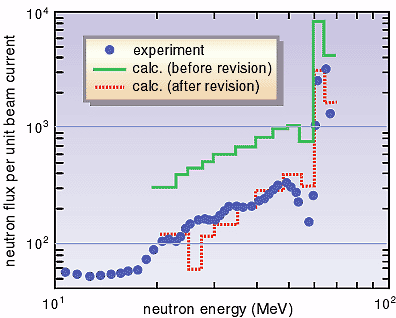Recent rapid progress in accelerator technology has broadened
its applications to varied and familiar areas in industry and
medical care. The acceleration energy now extends from several
MeV to several hundred MeV. However, increasing the thickness
of the bulk shield becomes a major issue for the construction
cost of the facility, because penetrable high energy neutrons
are inevitably associated with high energy machines. To deal with
this problem, JAERI has prepared a unique high energy neutron
source device at the AVF cyclotron facility as shown in Fig. 10-7.
It can provide quasi-monoenergetic neutrons of excellent quality
with low background; that is achieved by separation between the
neutron source and the measurement room by a thick shield wall
(Fig. 10-8).
The transmission and energy change behavior of neutrons were measured
on shielding media as iron and concrete of various thicknesses
at this device. Based on the data obtained, examinations were
made of the theoretical predictions by calculation. An example
is shown in Fig. 10-9. As a result, it turned out that the theoretical
predictions so far made gave larger values than the experi-mental
ones, namely, they overestimated the transmission. The present
experimental data leads to modification of the theoretical prediction
resulting in remarkable improve-ment of the accuracy. Hence, it
is expected that the optimization of the thickness of shielding
reduces the construction cost, while keeping enough safety for
the accelerator facility. |


